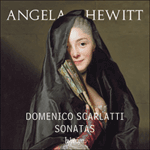A brief fanfare is followed by hustle and bustle, a gathering of people perhaps for a big event. It turns into a moto perpetuo, greatly enhanced by the game of hand-crossing and the harmonic excursions. In the Venice manuscript the tempo indication is Allegro; in the Parma one it is Vivo. Longo used his own Allegrissimo. I think it is important not to race through it too fast, otherwise the character is lost. Godowsky made an arrangement of this sonata and included it in his suite
Renaissance. Although he adds a tonne of notes, he strangely takes out almost all of the hand-crossings.
from notes by Angela Hewitt © 2016
Une courte fanfare suivie d’une certaine effervescence, une réunion de gens peut-être pour un grand événement. Elle se transforme en moto perpetuo, très rehaussé par le jeu du croisement des mains et les excursions harmoniques. Dans le manuscrit de Venise, l’indication de tempo est Allegro; dans celui de Parme, c’est Vivo. Longo a utilisé son propre Allegrissimo. Je pense qu’il est important de ne pas trop se précipiter, sinon on en perd le caractère. Godowsky a fait un arrangement de cette sonate et l’a inclus dans sa suite
Renaissance. Bien qu’il ajoute une tonne de notes, il retire étrangement presque tous les croisements de mains.
extrait des notes rédigées par Angela Hewitt © 2016
Français: Marie-Stella Pâris
Auf eine kurze fanfarenartige Figur folgt geschäftiges Treiben, etwa wie eine Menschenansammlung kurz vor einem großen Ereignis. Das verwandelt sich dann in ein Moto perpetuo, welches durch Handüberkreuzungen und harmonische Abstecher noch deutlich aufgebessert wird. In dem Manuskript aus Venedig lautet die Tempobezeichnung Allegro; im Manuskript aus Parma hingegen Vivo. Longo gab seine eigene Vorgabe an, nämlich Allegrissimo. Meiner Ansicht nach ist es wichtig, nicht allzu schnell durchzurasen, da sonst der Charakter des Stücks untergeht. Godowsky fertigte ein Arrangement dieser Sonate an und nahm es in seine
Renaissance-Suite auf. Zwar fügt er jede Menge Töne hinzu, nimmt allerdings eigentümlicherweise fast alle Überkreuzungen heraus.
aus dem Begleittext von Angela Hewitt © 2016
Deutsch: Viola Scheffel

 Harold Bauer - The complete recordings
Harold Bauer - The complete recordings Gramophone» More
Gramophone» More Scarlatti (D): Sonatas, Vol. 1
Scarlatti (D): Sonatas, Vol. 1
